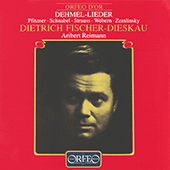
Conrad Ansorge (1862 - 1930)
Conrad Ansorge studied at the Leipzig Conservatory then, at the age of twenty-three, went to Liszt, joining the famous master-classes given by Liszt in the final years of his life. Ansorge’s classmates included Frederic Lamond and Moriz Rosenthal, and he played for the master such works as Liszt’s own ‘Paganini’ Studies and Grande Fantaisie on themes from Meyerbeer’s Les Huguenots, polonaises by Chopin, and Beethoven’s Variations and Fugue on a theme from Prometheus Op. 35 (‘Eroica’ Variations). Following his time with Liszt he toured America, but in 1893 returned to Weimar to teach and compose. Here he formed a close relationship with Rudolf Steiner, the Austrian founder of anthroposophy, who expressed delight at hearing Ansorge’s settings of Nietzsche and Dehmel. Steiner felt that the city of Weimar restricted the artistic development of both himself and Ansorge, and both moved to Berlin at around the same time, Ansorge joining the staff of the Klindworth-Scharwenka Conservatory. He led the life of a performer, teacher and composer, his works including a Requiem for male chorus, a string sextet, two string quartets, and three piano sonatas. In 1920 he became head of the piano department of the German Academy in Prague.
Although he played much Romantic and virtuoso music in his youth, Ansorge, possibly influenced by Steiner, gradually gained the reputation of an intellectual pianist. His most famous pupil was Eduard Erdmann, a pianist of similar style. Both had repertoires based on Beethoven, Schumann and Schubert, and Ansorge was particularly renowned for his playing of Beethoven’s sonatas.
Ansorge made only a few recordings: five sides for German Parlophone were recorded around 1928, and some Beethoven recordings for German Vox a year or so before, including the ‘Moonlight’ and ‘Pathetique’ Sonatas. One of the works he recorded, Liszt’s Glanes de Woronince, is a rarity. It is based on Chopin’s song The Maiden’s Wish, which, together with five other songs by Chopin, Liszt also transcribed for piano. It must be among the rarest of Liszt’s works to have been recorded by one of his pupils. Ansorge also recorded the Andante from Mozart’s Sonata in C major, K. 330, another unusual piece for the time. In this, and the Schumann and Liszt recordings, it is clear that Ansorge was an intelligent pianist, but perhaps one of the less interesting pupils of Liszt to have made recordings.
© Naxos Rights International Ltd. — Jonathan Summers (A–Z of Pianists, Naxos 8.558107–10).

















